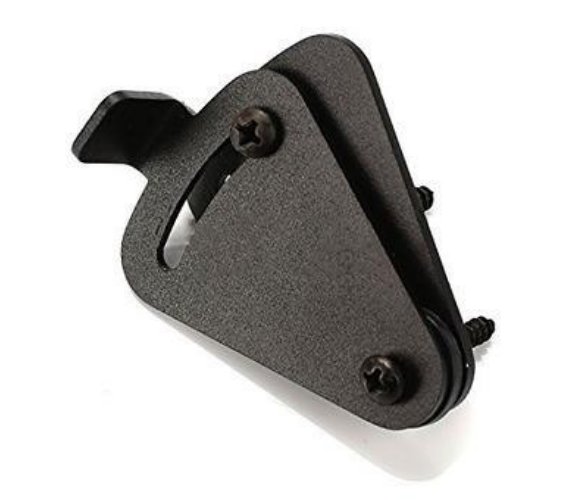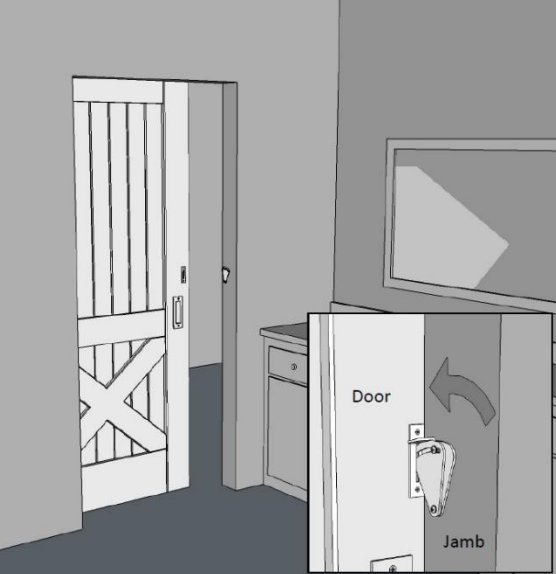How To Lock Sliding Barn Doors
Sliding barn doors are a little more difficult to lock than traditional swinging doors, but it’s still possible. There are a handful of different barn door lock styles and here at White Shanty we prefer the hook and eye latch or the tear drop latch. We’ve chosen these two styles for their elegance and simplicity - both in terms of installation and use.
Is A Sliding Barn Door Lock Secure?
A locked barn door will not be as secure as a traditional style door, because the traditional door uses the door frame for security, and a locked door cannot be removed from its hinges. If someone was intent on breaking into a room with a locked barn door, they could simply use a screwdriver to remove the jump stops, and remove the door from the wall. A sliding barn door is not the right choice for high security applications.
With that being said, most people are looking to lock their sliding barn door for privacy, or to prevent the door from accidentally being opened (common in households with kids and pets). It’s easy to add a locking mechanism to a bathroom barn door or bedroom barn door, or any other room where you want a little extra privacy.
Sliding Door Lock Types
Tear Drop Latches

The tear drop latch is a simple locking mechanism where a tear drop shaped piece of metal is mounted to the door or the wall, and rotates out into a catch plate installed on the opposing surface. This lock is simple and elegant, and can be installed in a few minutes using a drill, tape measure and screwdriver.

The lock can be installed in either orientation, depending on which side of the door the lock is on. If you’re installing the lock on the inside of the door, you will need to mount the tear drop to the door jamb and the catch plate to the door.

On the outside, you will need to do the opposite and mount the catch plate to the wall, and the tear drop to the door.
Hook & Eye Latches

A hook and eye latch is a simple locking style where a hook is mounted to one surface, and can be pivoted to slot into a circular latch on the opposing surface. The hook and eye latch is a more forgiving lock system in terms of installation and use. Whereas the tear drop latch requires close alignment between the door and the wall, the hook and eye latch can be used when there is a larger gap.
The hook and eye latch can be installed in either configuration on the inside or outside of the door. However, we recommend installing the eye on the door and the hook on the door jamb/wall. This prevents the hook from swinging around when the door is slid open or closed.
Hasp Lock
A hasp lock is a style where a hinged plate pivots over a fixed knob, and the lock is secured by turning the knob, or adding a physical padlock. The hasp lock is a more utilitarian design which adds bulk and changes the visual aesthetic of the door. Additionally, sliding barn doors require a hasp lock with a 90 degree bend which adds extra cost and complexity. For that reason, we do not recommend hasp locks.
Cane Floor Bolt
Another type of sliding barn door lock is the cane floor bolt, which mounts a sliding rod to the bottom of the door. The rod can then be pivoted and lowered into a hole in the floor, which prevents the door from sliding open. This lock adds very little additional security, and requires drilling into the floor.
Other Lock Designs
There are a wide variety of other lock designs, but many add significant complexity without any increase in security. In many situations, more advanced locks require significant modifications to the door or the door jamb, which drives up the installation time and cost. We have found the hook and eye latch or tear drop latch to be the simplest, most effective and most affordable solution.
Lock Placement
Lock placement is the last consideration, but most locks are compatible on either the inside or outside of the door. For bathrooms or bedrooms, mounting the lock on the inside makes more sense since you will be in the room when the door is locked. For closets, pantries or storage spaces, placing the lock on the outside makes more sense to prevent children or pets from getting into places where they’re not supposed to. Unfortunately, the majority of locking solutions can only be accessed from one side of the door.
